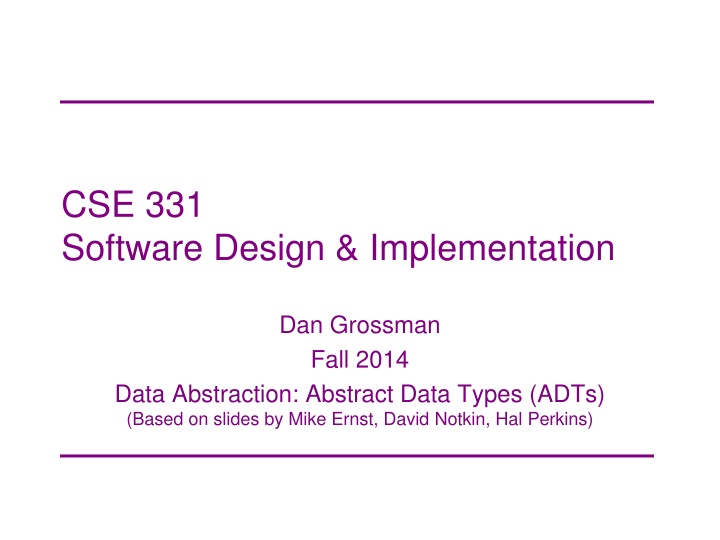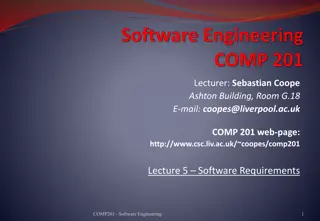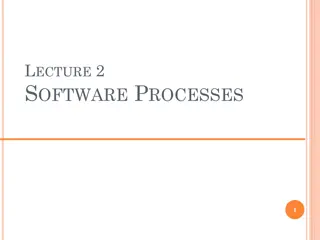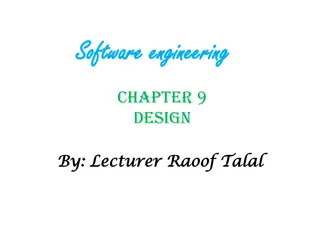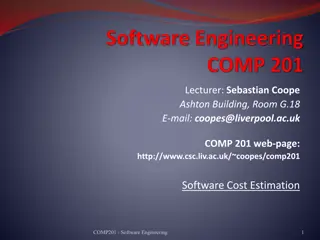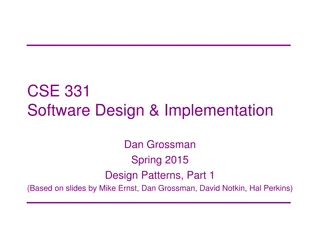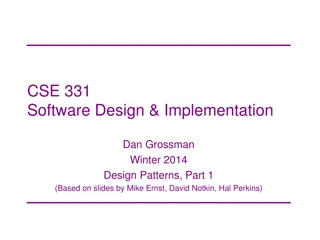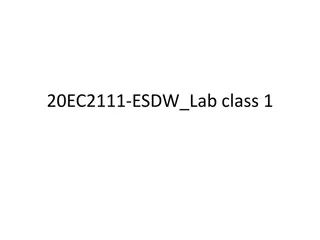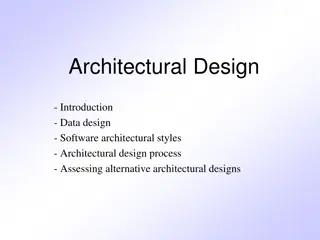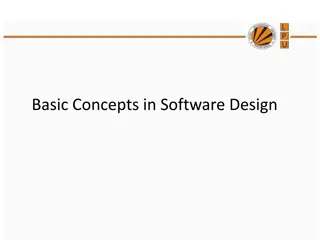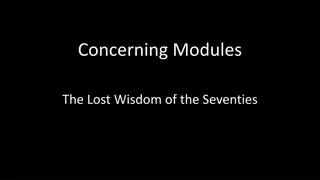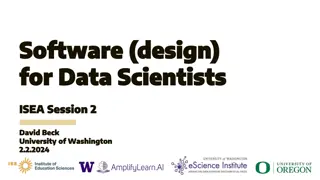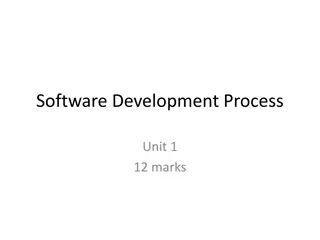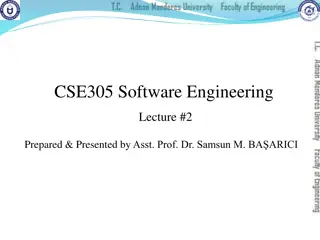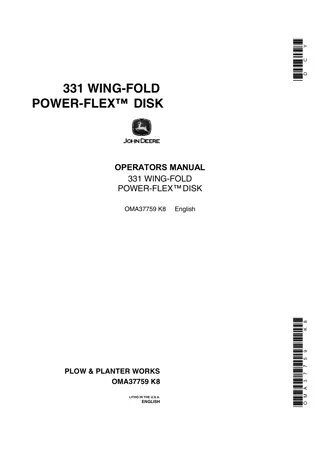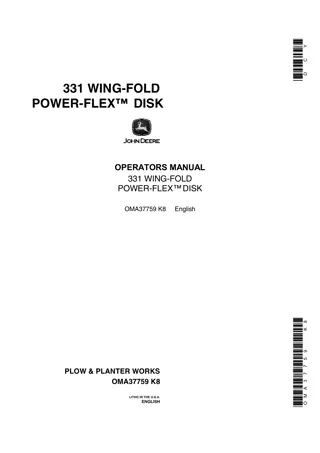CSE 331 Software Design & Implementation
Dive into the concepts of Abstract Data Types (ADTs) with a focus on data abstraction, procedural abstractions, and the methodology for ADT design. Explore the importance of ADTs in organizing and manipulating data efficiently, and learn how to structure data operations effectively.
Download Presentation

Please find below an Image/Link to download the presentation.
The content on the website is provided AS IS for your information and personal use only. It may not be sold, licensed, or shared on other websites without obtaining consent from the author.If you encounter any issues during the download, it is possible that the publisher has removed the file from their server.
You are allowed to download the files provided on this website for personal or commercial use, subject to the condition that they are used lawfully. All files are the property of their respective owners.
The content on the website is provided AS IS for your information and personal use only. It may not be sold, licensed, or shared on other websites without obtaining consent from the author.
E N D
Presentation Transcript
CSE 331 Software Design & Implementation Dan Grossman Fall 2014 Data Abstraction: Abstract Data Types (ADTs) (Based on slides by Mike Ernst, David Notkin, Hal Perkins)
Outline This lecture: 1. What is an Abstract Data Type (ADT)? 2. How to specify an ADT? 3. Design methodology for ADTs Very related next lectures: Representation invariants Abstraction functions Two distinct, complementary ideas for reasoning about ADTs CSE331 Fall 2014 2
Procedural and data abstractions Procedural abstraction: Abstract from details of procedures (e.g., methods) Specification is the abstraction Abstraction is the specification Satisfy the specification with an implementation Data abstraction: Abstract from details of data representation Also a specification mechanism A way of thinking about programs and design Standard terminology: Abstract Data Type, or ADT CSE331 Fall 2014 3
Why we need Data Abstractions (ADTs) Organizing and manipulating data is pervasive Inventing and describing algorithms is less common Start your design by designing data structures How will relevant data be organized What operations will be permitted on the data by clients Cf. CSE 332 Potential problems with choosing a data abstraction: Decisions about data structures often made too early Duplication of effort in creating derived data Very hard to change key data structures (modularity!) CSE331 Fall 2014 4
An ADT is a set of operations ADT abstracts from the organization to meaning of data ADT abstracts from structure to use Representation should not matter to the client So hide it from the client class RightTriangle { float base, altitude; } class RightTriangle { float base, hypot, angle; } Instead, think of a type as a set of operations create, getBase, getAltitude, getBottomAngle, Force clients to use operations to access data CSE331 Fall 2014 5
Are these classes the same? class Point { public float x; public float y; public float theta; } } class Point { public float r; Different: cannot replace one with the other in a program Same: both classes implement the concept 2-d point Goal of ADT methodology is to express the sameness: Clients depend only on the concept 2-d point CSE331 Fall 2014 6
Benefits of ADTs If clients respect or are forced to respect data abstractions For example, it s a 2-D point with these operations Can delay decisions on how ADT is implemented Can fix bugs by changing how ADT is implemented Can change algorithms For performance In general or in specialized situations We talk about an abstraction barrier A good thing to have and not cross (also known as violate) CSE331 Fall 2014 7
Concept of 2-d point, as an ADT class Point { // A 2-d point exists in the plane, ... public float x(); public float y(); public float r(); public float theta(); Observers // ... can be created, ... public Point(); // new point at (0,0) public Point centroid(Set<Point> points); Creators/ Producers // ... can be moved, ... public void translate(float delta_x, float delta_y); public void scaleAndRotate(float delta_r, } Mutators float delta_theta); CSE331 Fall 2014 8
Abstract data type = objects + operations Point x y r theta translate scale_rot abstraction barrier rest of program clients implementation Implementation is hidden The only operations on objects of the type are those provided by the abstraction CSE331 Fall 2014 9
Specifying a data abstraction A collection of procedural abstractions Not a collection of procedures An abstract state Not the (concrete) representation in terms of fields, objects, Does not exist but used to specify the operations Concrete state, not part of the specification, implements the abstract state More in upcoming lecture Each operation described in terms of creating , observing , producing , or mutating No operations other than those in the specification CSE331 Fall 2014 10
Specifying an ADT Mutable Immutable 1. overview 2. abstract state 3. creators 4. observers 5. producers (rare) 6. mutators 1. overview 2. abstract state 3. creators 4. observers 5. producers 6. mutators Creators: return new ADT values (e.g., Java constructors) Producers: ADT operations that return new values Mutators: Modify a value of an ADT Observers: Return information about an ADT CSE331 Fall 2014 11
Implementing an ADT To implement a data abstraction (e.g., with a Java class): See next two lectures This lecture is just about specifying an ADT Nothing about the concrete representation appears in the specification CSE331 Fall 2014 12
Poly, an immutable datatype: overview /** * A Poly is an immutable polynomial with * integer coefficients. A typical Poly is * c0 + c1x + c2x2 + ... **/ class Poly { Abstract state (specification fields) Overview: State whether mutable or immutable Define an abstract model for use in operation specifications Difficult and vital! Appeal to math if appropriate Give an example (reuse it in operation definitions) State in specifications is abstract, not concrete CSE331 Fall 2014 13
Poly: creators // effects: makes a new Poly = 0 public Poly() // effects: makes a new Poly = cxn // throws: NegExponent if n < 0 public Poly(int c, int n) Creators New object, not part of pre-state: in effects, not modifies Overloading: distinguish procedures of same name by parameters (Example: two Poly constructors) Footnote: slides omit full JavaDoc comments to save space; style might not be perfect either focus on main ideas CSE331 Fall 2014 14
Poly: observers // returns: the degree of this, // i.e., the largest exponent with a // non-zero coefficient. // Returns 0 if this = 0. public int degree() // returns: the coefficient of the term // of this whose exponent is d // throws: NegExponent if d < 0 public int coeff(int d) CSE331 Fall 2014 15
Notes on observers Observers Used to obtain information about objects of the type Return values of other types Never modify the abstract value Specification uses the abstraction from the overview this The particular Poly object being accessed Target of the invocation Also known as the receiver Poly x = new Poly(4, 3); int c = x.coeff(3); System.out.println(c); // prints 4 CSE331 Fall 2014 16
Poly: producers // returns: this + q (as a Poly) public Poly add(Poly q) // returns: the Poly equal to this * q public Poly mul(Poly q) // returns: -this public Poly negate() CSE331 Fall 2014 17
Notes on producers Operations on a type that create other objects of the type Common in immutable types like java.lang.String String substring(int offset, int len) No side effects Cannot change the abstract value of existing objects CSE331 Fall 2014 18
IntSet, a mutable datatype: overview and creator // Overview: An IntSet is a mutable, // unbounded set of integers. A typical // IntSet is { x1, ..., xn }. class IntSet { // effects: makes a new IntSet = {} public IntSet() CSE331 Fall 2014 19
IntSet: observers // returns: true if and only if x this public boolean contains(int x) // returns: the cardinality of this public int size() // returns: some element of this // throws: EmptyException when size()==0 public int choose() CSE331 Fall 2014 20
IntSet: mutators // modifies: this // effects: thispost = thispre {x} public void add(int x) // modifies: this // effects: thispost = thispre - {x} public void remove(int x) CSE331 Fall 2014 21
Notes on mutators Operations that modify an element of the type Rarely modify anything (available to clients) other than this List this in modifies clause (if appropriate) Typically have no return value Do one thing and do it well (Sometimes return old value that was replaced) Mutable ADTs may have producers too, but that is less common CSE331 Fall 2014 22
